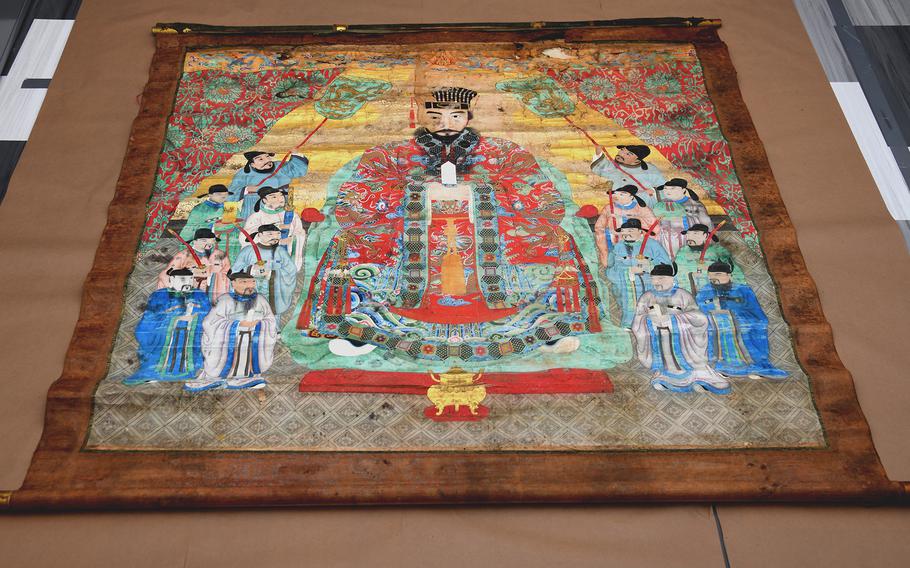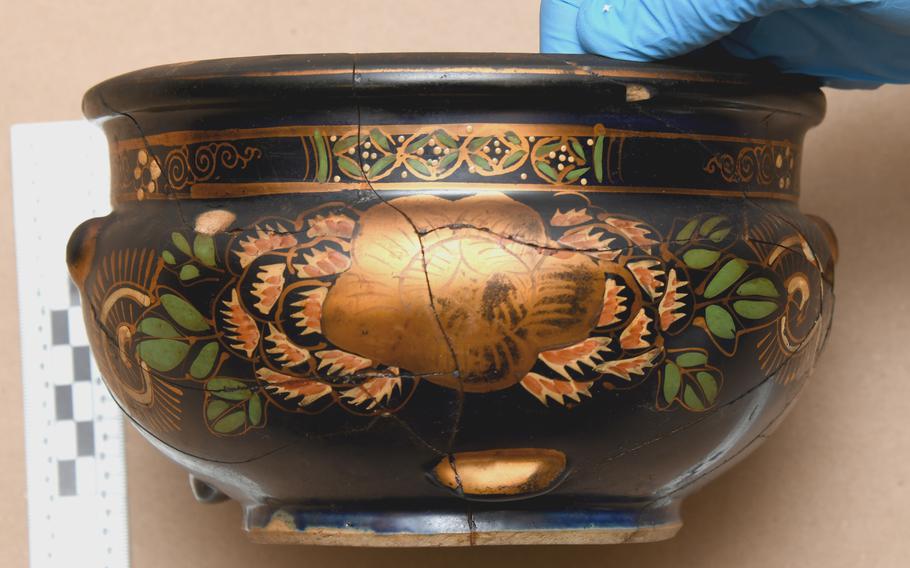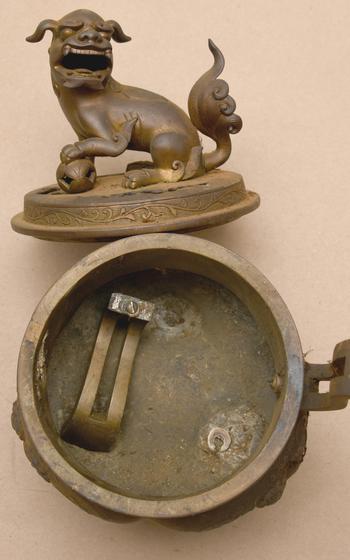
The U.S. military recently teamed up with the FBI and the Smithsonian Institution to return 22 artifacts missing since World War II to Okinawa. (Federal Bureau of Investigation)
The recent return to Japan of artifacts believed to have been looted by U.S. troops during World War II has rekindled interest in other treasures lost during the Battle of Okinawa nearly 80 years ago.
The U.S. military teamed up with the FBI and the Smithsonian Institution to return 22 artworks and other items missing since World War II to Okinawa in January, according to a March 15 FBI statement.
The items, including paintings of Okinawan kings, scrolls, pottery and an ancient map, were found last year among a deceased World War II veteran’s belongings in Massachusetts, according to Geoffrey Kelly, an FBI special agent in Boston.
The FBI got on the case after a representative of the veteran’s family reported the items, Kelly said by phone Tuesday.
It turned out that some of the artifacts, likely taken by U.S. troops during the 1945 Battle of Okinawa, were listed on the FBI’s National Stolen Art File, Kelly said.
“A lot of soldiers were treasure hunters and wanted to take souvenirs home,” he said. “It may have seemed to them as something they were entitled to do, but any items that were taken need to go back.”
Ryukyu jewels
The search is still on for other artifacts that went missing during the war, including the crown jewels of the old Ryukyu Kingdom, Kelly said. The kingdom ruled Okinawa for centuries before it was incorporated into Japan in 1879.
Some items believed to be taken with the crown jewels were discovered in 1953, also in Massachusetts, Kelly said.
Among those items was the Omoro Sochi — 22 volumes of ancient Okinawan poems and songs dating to the 12th century or beyond, according to a June 24, 1996, report in Stars and Stripes.
Those items, including books, a gold-encrusted headpiece, statues of gods, family altars and beads from a thousand-year-old necklace worn by a high priestess, were recovered by the U.S. Customs Service from a former Navy lieutenant who had acquired them on Okinawa.

This piece of ornate pottery was one of 22 recovered artifacts recently returned to Okinawa with the help of the U.S. military, the FBI and the Smithsonian Institute. (Federal Bureau of Investigation)
The relics, along with the crown jewels, were buried and hidden in a cave near Shuri Castle on Okinawa by stewards of the royal family as U.S. forces bombed and shelled the island in 1945, Bokei Maehiro, a surviving steward, said in 1996.
On his return to the items’ hiding places, Maehiro “discovered although the area had not been bombed, the crown and other articles such as the Omoro Sochi, some historical files, were completely removed,” he wrote in 1953 requesting the U.S. civil government on Okinawa to search for the jewels.
In late 1946, Maehiro learned that American officers, with the help of several Japanese Americans, had looted the cave and spirited the treasures back to the U.S.
Modern monuments men
The FBI is confident the veteran who kept the recently returned Okinawan treasures didn’t take them from the island, since he didn’t serve in the Pacific, Kelly said.
The National Museum of Asian Art at the Smithsonian helped the FBI package the items for transport to Japan, he said.
Video clips provided by the U.S. Consulate General on Okinawa show the artifacts being loaded onto a U.S. Air Force C-17 Globemaster II at Stewart Air National Guard Base, N.Y., in January.
Soldiers from the U.S. Army Civil Affairs and Psychological Operations Command (Airborne) escorted the artifacts during the trip.
The unit is the modern equivalent of troops depicted in the 2014 film, “The Monuments Men,” who recovered art looted by the Nazis in World War II, Kelly said.

One of 22 recovered items, missing since World War II, that were recently returned to Okinawa with help of the U.S. military. (Federal Bureau of Investigation)
“We care about Okinawan cultural heritage, and we want to support it,” Col. Andrew DeJesse, a unit member who traveled with the items to Okinawa, said in a Jan. 10 video provided by the consulate. “It’s the same exact action as what the monuments men of World War II did.”
Okinawa Gov. Denny Tamaki said the returned relics included portraits believed to depict Ryukyu kings, he said at a March 15 press conference.
“I think it is a great joy for the people of Okinawa that these treasures of Okinawa, which you can experience the Ryukyu Kingdom era, have returned,” he said.
The royal portraits may be the first ever discovered, an Okinawan cultural resources division official said by phone Tuesday. Japanese officials typically speak to the press on condition of anonymity.
“They will be culturally and artistically important resources,” he said.
The paintings won’t be publicly displayed until they are restored, a process that could take years, the official said.
“Since this case will serve as a model case, we hope this will lead to the discovery and return of valuable lost cultural properties, such as the undiscovered crown of the Ryukyu Kingdom,” he said.